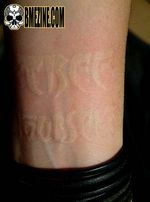White ink
Jump to navigation
Jump to search
Tattoo ink sits underneath a layer of translucent skin. Tattoo ink is opaque and, as such, in theory, any color is possible, including white. However, as skin is translucent, not clear, there will be a slight amount of discoloration. The amount will vary from almost nothing to usually nothing more than a mild "yellowing" effect, although for people with darker skin tones the change can be dramatic.
It should also be noted that from the tattoo artist's point of view, because the white ink can be hard to see in a fresh tattoo, it takes an experienced artist to put in large, even areas. The most common use for white ink is highlighting. Finally, many artists also use white ink to lighten a tattoo before a coverup.



